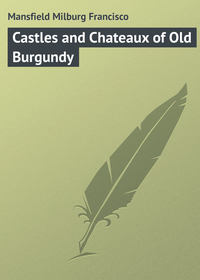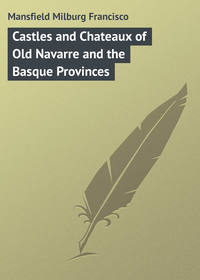 полная версия
полная версияThe Cathedrals of Northern France
As a type to admire, there is no doubt but that the cathedral that possesses an apsidal termination of the easterly or choir end, as is nearly the universal custom in France, has charms and beauties which may be latent, but which are simply winning, when it comes to picturing the same structure with the squared-off ends so common in England.
It was Stevenson, was it not, who wrote of the satisfaction with which one always looks upon the east end of a French cathedral, "flanging out as it often does in sweeping terraces, and settling down broadly upon the earth as though it were meant to stay." Certainly nothing of the sort is to be more admired than the rare view of the choir buttresses of Notre Dame at Paris, likened unto "kneeling angels with half-spread wings;" the delicate and symmetrical choir buttresses of Amiens; the sheer fall of Beauvais; or the triply effective termination of the one-time cathedral of Noyon, which falls away in three gracefully gentle slopes to the ground. Again Stevenson's power as a descriptive writer lingers in our memory. He says, of no cathedral in particular, "where else is to be found so many elegant proportions growing one out of the other, and all together in one?.. Though I have heard a considerable variety of sermons, I have never yet heard one that was so expressive as a cathedral. 'Tis the best preacher itself, preaches day and night, not only telling you of man's art and aspirations in the past, but convicting your own soul of ardent sympathies; or rather, like all good preachers, it sets you preaching to yourself, – and every man is his own doctor of divinity in the last resort."
To best estimate the charms and values of these architectural monuments one should consider; first, the history and topography of their environment, —i. e. as to why and when they may have been planned and built; secondly, their personality, as it were, – who were their founders, their patrons, their bishops; thirdly, the functions in which they may have partaken, any significant events which may have passed within their walls or centred within their sees; and fourthly, the artistic beauties of their fabric and its embellishments.
In most cases all of these values are so interwoven and indissolubly linked with the growth of the structure itself from its very earliest foundations that it is hardly possible to detail this information in true chronological order. The picturesque and romantic elements, of which there is not a little; the sordid and baneful, of which we may wish there were less; and the splendid ceremonials of Church and State; all go to make up a chronicle which no account, of even a special nature, could afford to neglect.
The picturesque elements of the conversion and baptism of Clovis by St. Remi at Reims in 496, where, on the site of the present cathedral, he was adjured to "revere that which thou didst burn and burn that which thou didst revere," and the crowning on the same spot of Charles VII. in 1429 through the efforts of the Maid, well represent these phases. The meanness and the unjustness of her later trial and condemnation in the Abbey Church of St. Ouen at Rouen is another. The affairs of state consist chiefly of the coronation ceremonies which mostly took place at Reims, and present a splendid record. Of the monarchs from 1173 onwards who were not here crowned, Henry IV. was crowned at Chartres; Napoleon I., at Paris; Louis Philippe, Louis XVIII., and Napoleon III. were not crowned at all.
Throughout this continuity of state events these great churches were performing their natural functions of the dissemination of the Word. Jealousies and bickerings took place, to be sure, but in the main there was harmony, if rivalry did exist; else it were not possible that so many of these splendid monuments would have endured to remind us of their past as well as present existence.
Certain of the sees were merged into greater ones, and others were abandoned altogether. In this connection there is a curious circumstance with regard to the one-time Bishop of Bethléem, who, driven from the Holy Land, was given a see at Clamecy, which see comprehended only the village in which he resided. What remains of the former cathedral is now an adjunct to a hotel. The rearrangement of political divisions of France after the Revolution was the further excuse for establishing but one diocese to a department, until to-day there are but eighty-four sees, administered by sixty-seven bishops and seventeen archbishops.
The itinerary of the conventional tour of the Continent usually keeps well to the beaten track, and so does the conventional traveller. He does not always get over to Reims, and often does not stop en route at Amiens; seldom visits Beauvais, and, unless he specially sets out to "tour" Brittany, a popular enough amusement of the lean of purse in these days, knows little of the unique charms of Tréguier, Quimper, or even of Le Mans, with its sublime choir, or of Evreux. As for even a nodding acquaintance with Noyon or Soissons, two of the most convincingly beautiful and impressive transitory types, they might as well be in the wilds of Kamchatka, though they are both situated in a region well travelled on all sides; while Laon, not far distant, is hardly known at all, except as a way station en route to Switzerland. The cathedrals of mid-France are, it is to be feared, even less known than would on first thoughts seem probable. A certain amount of sentimentality attaches itself to the chateaux of the Loire, and some acquaintance with their undeniable pleasing attributes is the portion of most travellers; but, again, such cathedral cities as Besançon, Nantes, and Langres are off the well-worn road, and their cathedrals might be myths so far as a general acquaintance with them is concerned; while the splendid churches of Bourges, Nevers, and Autun are likewise practically unknown to the casual traveller.
Tours, Orleans, and Chartres alone appear to be the only recognized representatives of this section of France which have hitherto attracted due attention.
With the southland this volume does not deal; that is a subject to be considered quite by itself, – and significantly, more real interest has been shown with respect to the architectural monuments of Avignon, Arles, Nîmes, Le Puy, Périgueux, Carcassonne, and Poitiers than to those of the Midi. Is it that the days of cheap travel and specially conducted tours, when ten or fifteen guineas will take one to the Swiss or Italian lakes, or e'en to Rome and Florence, has caused this apparent neglect of the country lying between? Certainly our forefathers travelled more wisely, but then prices and means of locomotion were on quite a different scale in those days, and not infrequently they were obliged to confine their travels and observations to more restricted areas.
Perhaps the most lucid arrangement of architectural species is that given by De Caumont's "Abécêdaire d'Architecture," which divides the country ethnologically into Brittany; Normandy; Flanders, including Artois and Picardy; Central France (the Isle of France, Champagne, Orleanois, Main, Anjou, Touraine, and Berri); and Burgundy, comprehending the former divisions of Franche Comté, Lorraine, Alsace (now Belfort), Nivernois, Bourbonnois, and Lyonnois. Of the above divisions, only that of the Isle of France with La Brie was originally held by the Crown. The political divisions throughout France now number eighty-seven departments, taking their names from the principal topographical features, and replacing in 1790 the thirty-two mediæval provinces, each of which had their own characteristics of social and political life, and of which each in turn progressed, stagnated, or fell backward according to local or periodical conditions. Both the arts of peace and of war have left an ineradicable impress. In the thirteenth century the various provinces became welded together into one perfect whole under Philippe Augustus and the sainted Louis, but retained to no small extent, even as they do unto to-day, their distinctive local characteristics.
Because of its cathedrals alone, the Isle of France stands preëminent among the provinces for each of the thirteen provincial styles of architecture which are allocated by the Société des Monuments Historiques. A comparatively small and unified province, it comprehends within and contiguous to its borders more of the attributes and principles of a consistent Mediæval architectural style than is elsewhere to be observed. From Rouen on the west to Reims on the east, northward to Amiens and southwesterly to Chartres, are grouped the show pieces of the world's Gothic architecture. Not alone with the respect to the Grand Cathedrals is this region so richly endowed, but also because of the smaller and less important, but no less attractive or interesting examples of Noyon, Senlis, Laon, Soissons, with their one-time cathedral churches and other varied ecclesiastical and secular edifices.
Beauvais, Gisors, Gourney, Cires-les-Mello, Creil, Royamont, Nogent-les-Vierges, Villers-St. – Pol, indeed nearly every village and town within the royal domain, present values and comparisons which place nearly all of its contemporary structures, be they large or small, at a grand height above those of other less prolific sections. Lest it be thought that this statement is drawn largely, and that fineness and balance of estimate are lacking, it suffices to state that it is not alone from study and research, but from frequent personal intimacies that the region has ever proved an inexhaustible store of architectural values, and one which most well-known authorities, with one accord, place in the very first rank.
Arthur Young, than whom no more perspicuous observer has ever chronicled his impressions, wrote (1704) that to see the best of France, the part most varied in topography, and resourceful and attractive in its monuments, one should land at Havre and follow the sinuosity of the Seine to Paris, thence the highroad to Moulins and on to the Rhône at Valence, an outline which somewhat approaches the limitations of territory of which this book treats. To be sure, he wrote of economic and agricultural conditions, and he mostly made his pertinent observations on land holdings, stock keeping, and hedgerows, or rather that lack of them which is so apparent throughout France; but these details of themselves only suggest more complete evidences of the existing forces which indicate the growth of the wealth and power which has made this region so rich in its architectural memorials of the past, and which ought to more than compensate for any lack of scenic grandeur.
It is to be regretted, of course, that none of these larger cathedrals are to be seen to-day in their completely perfected forms. To what extent would not the glories of Reims, of Amiens, of Beauvais, or of Rouen, be enhanced, were it possible for us to even imagine their splendour, were they possessed of the symmetry and well-favoured situation of the Dom at Cologne? And so it is that we can but feel regret when we mentally note the lack of nave at Beauvais, of spires at Bourges, and, yet again, regret even with more pain the monstrousness of the cast-iron flêche which has been added to the central tower at Rouen. But these are after all minor imperfections – seldom, if ever, in aught but pleasurable anticipation, do we see in the masterpieces of art or nature a perfect unity; so why seek to negative their virtues by futile criticism? It would seem to be all-sufficient that such details, sins of omission or commission, should be noted merely, that we may pass on to other charms which must compel our allegiance.
When we visit the cathedrals of the Isle of France, we are at once in the midst of the best examples of French Gothic architecture, or of French Mediæval architecture, if the phrase is to be preferred.
PART I
Transition Examples
I
INTRODUCTORY
Soissons, with Noyon and Laon, all within perhaps thirty miles of one another, may be said to best represent the nurturing and development of the early Gothic of France. These simple and somewhat plain types exemplify the style which was in vogue at the same time in the Low Countries. It is good Gothic, to be sure, – at least, good as to its planning, – but without that ornateness or lightness known to-day as characteristic of the distinctive French type, which so early developed boldly and beautifully.
One observes the resemblances in style between the notable cathedral at Tournai, in Belgium, the neighbouring types of French Flanders, and the cathedrals of this trinity of French towns lying contiguous thereto, Noyon itself being for long interdependent with the see of Tournai. Nevertheless, it is a beautiful type which was cradled here in the country called, by Cæsar, Suessiones; and difficult it would be to attempt to assign preëminence to any one edifice.
Noyon, without a doubt, has the greatest charm of environment, and is of itself in every way a pleasing and satisfying example of what should most truly inspire and impress us in a cathedral. Stevenson describes it as being "the happiest inspiration of mankind, a thing as specious as a statue at the first glance, yet, on examination, as lively and interesting as a forest in detail. The height of its spires cannot be taken by trigonometry: they measure absurdly short, but how tall they are to the admiring eye… I sat outside of my hotel and the sweet groaning thunder of the organ floated out of the church like a summons"; – and much more of the same sort, all of which tells us that, once we find ourselves on a plane of intimacy with a great church, we continually receive new impressions and inspirations, and it is in this vein that one who has known this group of simple but fascinating churches on their own ground, so to put it, can but seek to convey the idea that it is good that we have such contrasting types as a relief and an antidote to an appetite which otherwise might become sated.
II
NOTRE DAME DE LAON
For over twelve hundred years, until the see was abolished at the Revolution, Laon was the seat of a bishop who in point of rank was second only to the primate at Reims. Crowning the apex of a long isolated hill, upon which the entire town, now a fortress of the third class, is situated, the cathedral of Notre Dame de Laon, still so called locally, has endured since the beginning of the twelfth century, and may be considered a thoroughly representative transition example.
The present structure is on the site of one burned in 1112, and during comparatively recent years has been entirely restored.
Its crowning glory is in the disposition and number of its fine group of towers: two flank the western façade, and are rectangular at the base, dwindling to a smaller polygon, which is flanked with corner belfries and pierced by a tall lancet in the central structure, showing a wonderful lightness and open effect. A curious and unique feature of these towers is the addition of four oxen in carven stone perched high aloft in the belfries. These sculptured animals may be merely another expression of symbols of superstition, and if so are far more pleasing than some of the hideous and monstrous gargoyles ofttimes seen. Two other towers, each 190 feet in height, adjoin the transepts, to each of which is attached a double-storied, apsidal, ancient chapel. Two similarly projected towers are lacking. The lantern is square, with a shallow, conical, modern roof.
In the transition type Romanesque influences were evidently dying hard. The Gothic was seldom full blown, and at Laon shows but the merest trace of pointedness to the arches of the western façade, either in the portals or in the higher openings.
The lack of a circular termination to the choir is but another indication of a link with a transitory past; an undeniably false note and one very unusual in France, the choir being of the squared-off variety so common in England. This may be coincident with the English custom of the time, or it may be directly due to a local English influence; – most probably the latter, inasmuch as an English prelate held the see for a time, and the city, in the early fifteenth century, was for a number of years in English hands. It is significant that in some of the smaller churches of the diocese is to be noted the same treatment.
The rose windows of both the eastern and western façades are Gothic in inception and treatment, and are unusually acceptable specimens of these supreme efforts of the French mediæval builders, the glass therein being distinctly good, though perhaps not remarkable.
The transepts are rectangular and, with the ensemble of the entire structure, were their towers completed, there would be produced, not only a unique example, but a towering effect only a degree less interesting than the perfectly proportioned pyramidal form so much admired in the perfectly developed Gothic.
The interior is equally attractive with the exterior, and, though the church is not by any means of remarkable dimensions, it presents in its appropriate disposition of detail a far more roomy and pleasing arrangement than many a larger example.
The transepts are divided into a nave and side aisles, the columns which partition them, like those of the nave proper, being cylindrical and of massive proportions, which, however, lighten as they rise to the vaulting. They are unusually symmetrical when viewed together, the capitals of the lower series being ornately carved, each of a varying design.
Above the aisles are lofty galleries. The nave chapels were added in the sixteenth and seventeenth centuries. The stained glass, like that of the rose windows, is in the nave distinctly good, particularly that of the lower range on the southerly side. The pulpit, of carved wood of the Renaissance period, is not of the importance and quality of this class of work to be seen across the Rhine border.
The former Bishop's palace, adjoining the left of the choir, is now the Palais de Justice. A few remains of a former Gothic cloister are to be remarked, surrounded by the later construction.
III
NOTRE DAME DE NOYON
In Notre Dame at Noyon, Notre Dame at Laon, and the cathedral at Tournai, is to be noted the very unusual division of the interior elevation into four ranges of openings, this effect being only seen at Paris and Rouen among the large cathedrals. Noyon and Laon borrowed, perhaps, from Tournai, where building was commenced at least a century before either of the French examples first took form. It is perhaps not essential that such an arrangement be made in order to give an effect of loftiness, which might not otherwise exist; indeed, it is a question if the reverse is not actually the case, though the effect is undeniably one of grandeur. Soissons, too, may rightly enough be included in the group, though the points of resemblance in this case are confined to the rising steps to either transept, coupled with the joint possession of circumambient aisles, and at least the suggested intent of circular apsidal terminations to the transepts; though it appears that here this plan was ultimately changed and one transept finished off with the usual rectangular ending.
In this Noyon plainly excels, and there is found nowhere else in France the perfect trefoil effect produced by the apsidal terminations of both transepts and choir. So far as the transepts are concerned, they are of the manner affected by the builders on the Rhine, notably in the Minster at Bonn, at Cologne, and again at Neuss in the neighbourhood of Cologne. With Noyon apparently nothing is lacking either in the perfections of its former cathedral or in its immediate environment. The country round about is thoroughly agricultural, and free from the soot and grime of a manufacturing community. Amid a setting at once historic and romantic, it has for neighbours the chateaux of Coucy and Perrifonds, with Compiègne and Chantilly not far distant. The town is unprogressive enough, and the vast barge traffic of the Oise sidles by, not a mile away, as if it were all unconscious of the existence of any signs of modern civilization. As a matter of fact, it hardly is modern. The accommodation for the weary traveller is of a satisfying and gratifying quality, as the comparatively few visitors to the place well know. The city is an ancient foundation, having been known as the Noviodunum of the Romans. Here Charlemagne was crowned King of the Franks in 768, and Hugh Capet elected king in 987; and here, in an important stronghold of Catholicism, as it had long been, Calvin was born in 1509.
Altogether there is much to be found here to charm and stimulate our imagination. As a type the cathedral stands preëminent. As to detail and state of preservation, they, too, leave little to be desired, though the appreciative author of a charming and valuable work treating of a good half hundred or more of the "architectural glories of France" bemoans the lack of a satisfying daily "Office." This may be a fault, possibly, if such be really the case. The fabric of the church has stood the wear and tear of time and stress exceeding well. Built in the eleventh and twelfth centuries, it is a thoroughly harmonious and pleasing whole, and we can well believe all that may have been said of it by the few able critics who have passed judgment upon its style, as well as the sentiment conveyed by the phrase that it is "one of the most graceful and lovable of all the cathedrals of France." The bishopric was suppressed after the Revolution, and the church is now a dependency of the Bishop of Beauvais.
The elongated belfry towers are perhaps the first and most noticeable feature; secondly, the overhanging porch with its supporting frontal buttresses; thirdly, the before-mentioned tri-apsidal effect of the easterly end; and, last but not least, the general grouping of the whole structure in combination with the buildings which are gathered about its haunches, though with no suspicion of a detracting element as in some sordid and crowded cities, where, in spite of undeniable picturesqueness, is presented a squalor and poverty not creditable either to the city of its habitation or to the cathedral authorities themselves. From every point of vantage the steeples of Notre Dame de Noyon add the one ingredient which makes a unity of the entire ensemble, – a true old-world atmosphere, a town seen in not too apparent a state of unrepair and certainly not a degenerate.
The interior presents no less striking or noble features. It is not stupendous or remarkably awesome; but it is grand, with a subtleness which is inexpressible. Round and pointed arches are intermixed, and there is a notable display of the round variety in the upper ranges of the quadrupled elevation of the nave, the lightness, which might otherwise have been marred, being preserved through the employment of a series of simple lancets in the clerestory of the choir. Rearward of the south transept are the chapter-house and the scanty remains of a Gothic cloister, where a somewhat careworn combination of the forces of nature and art have culminated in giving an unusually old-world charm to this apparently neglected gem, as well representative of early French Gothic as any in existence to-day.
IV
NOTRE DAME DE SOISSONS
Soissons, the other primitive example, is at once a surprise and a disappointment. From the railway, on entering the town, one is highly impressed with the grouping of a sky-piercing, twin-spired structure of ample and symmetrical proportions; and at some distance therefrom is seen another building, possibly enough of less importance. Curiously, it is the cathedral which is the less imposing, and, until one is well up with the beautifully formed spires, he hardly realizes that they represent all that is left of the majestic Abbey of St. Jean des Vignes, where Becket spent nine long years. It is a mere bit of stage scenery, with height and breadth, but no thickness. It is a pity that such a charming structure as this noble building must once have been is now left to crumble. The magnificent rose window, or rather the circular opening which it once occupied, is now but a mere orifice, of great proportions, but destitute of glazing. The entire confines of the building, which crowns a slight eminence at the entrance of the town, are now given over to the use of the military authorities.
A little to the right lies the one-time cathedral of Notre Dame, Soissons being another of the ci-devant bishoprics suppressed after the Revolution by the redistribution which gave but one diocese to a Department. Though not unpleasing, its façade is marred by its lack of symmetry, while the tower, which rises on the right 215 feet, is not sufficiently striking to redeem what otherwise is an ordinary enough ensemble. The tower to the left was never raised above where it now ends, and the façade, lacking the charm which the edifice might otherwise have had, were the towers as complete and well proportioned as are those of a later date which grace the remains of the old abbey, will be for ever wanting until this completion be carried out.









